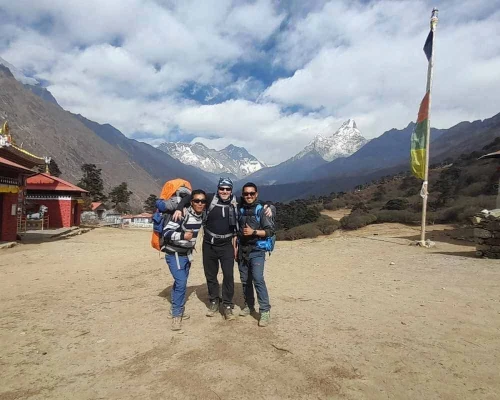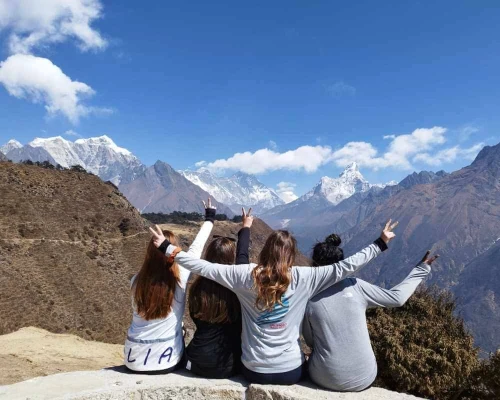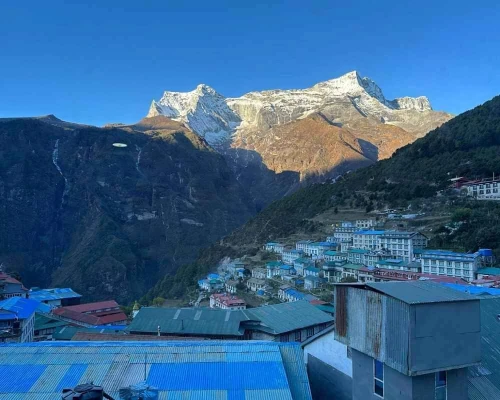Introduction: Everest View Trekking 2026
Everest View Trekking, also known as the Everest Panorama Trek, is a short yet delightful trekking experience in the Everest Region. Suitable for trekkers of all ages with decent physical fitness, this trek takes you to the land of the legendary Sherpa community. Enjoy the unique culture, traditions, and ancient heritage of the Sherpa people. Immerse yourself in the breathtaking scenery of mountains and marvelous landscapes. Witness the glorious and ever-enchanting Himalayas. On the Everest View Trekking Route, enjoy an excellent view of the world’s tallest peak, Mount Everest, without ascending into higher altitudes. This expedition provides the opportunity to meet the legendary Sherpa community. Furthermore, you can witness the diverse flora and fauna and marvel at the rich culture. This trek starts with a short flight to Lukla.
The Everest Panorama Trekking route starts by exploring Kathmandu city. The capital of Nepal, Kathmandu, is a cultural hub with links to Nepal's medieval history. A short flight of around 35 minutes takes us to the starting point of the trek. We land in the town of Lukla at the Tenzing Hillary Airport, an airport named after the first legendary climbers of Mt. Everest.
That day, we continued trekking to the village of Phakding. Our trek continues towards the unofficial Sherpa capital of Namche Bazaar. Along the way, we traverse forests adorned with rhododendrons and lush vegetation and cross many suspension bridges over the torrential Dudh Koshi River before entering the Sagarmatha National Park just outside the settlement of Jorsale. Along the trek, we will encounter the region's unique culture, marvelous views of the Himalayas, and a few challenging climbs.
We will see stunning views of Ama Dablam, Lhotse, Tawache, Kusum, Kangaroo, and other neighboring peaks. This area contains abundant wildlife, such as the rare and endangered Himalayan Thar, Danphe, Musk Deer, and more. Further on the Everest View Trekking Route trail, we explore the villages of Khumjung (a village with an ancient monastery known for housing the skull of a Yeti). The famous Tengboche Monastery, the highest point of our trek, is in the village of Tengboche.
Tengboche Monastery is the largest monastery in Khumbu Everest Region, the Tengboche Monastery is also the terminus site of the “Sacred Sites Trail Project.” This project covers 10 monasteries in the region. Furthermore, the village of Tengboche is surrounded by a marvelous panoramic view of the Himalayas. After exploring we will come back on the same trail and explore the villages of Khunde, Phortse, Jorsale, Benkar, Phakding, and others before wrapping up the trek at Lukla and flying back to Kathmandu.
Everest view trek is for trekkers who want to explore the region's beauty and experience the Himalayas' vastness quickly. March to May and mid-September to December are the preferred seasons for trekking. Join Nepal Trekking Planner Nepal for an enriching, delightful trek in the Everest Region with professional service and carefully planned itineraries that ensure your safety and comfort. In this trek, which can be introductory for novice adventurers, you can include your kids and elderly members for a fun and memorable experience that shall last a lifetime.
Everest View Trekking-11 Days Altitude and Distance Coverage
Day | Activity | Altitude (m/ft) | Distance (km/miles) | Duration (hours) | Elevation Gain (m/ft) |
1 | Arrival in Kathmandu. | 1,350 m / 4,430 ft | - | - | - |
2 | Full day in Kathmandu with sightseeing tour at places of interest. | 1,350 m / 4,430 ft | - | - | - |
3 | Fly to Lukla and trek to Phakding . | 2,860 m / 9,383 ft 2,610 m / 8,563 ft | 8 km / 5 miles | 3-4 hrs | -250 m / -820 ft |
4 | Trek to Namche Bazaar . | 3,440 m / 11,286 ft | 10.5 km / 6.5 miles | 5-6 hrs | +830 m / +2,723 ft |
5 | Rest day at Namche Bazaar for acclimatization and local excursions. | 3,440 m / 11,286 ft | 3 km / 1.86 miles | 2-3 hrs (optional hike) | +440 m / +1,444 ft |
6 | Trek to Tengboche . | 3,860 m / 12,664 ft | 9 km / 5.6 miles | 4-5 hrs | +420 m / +1,378 ft |
7 | Trek to Khumjung . | 3,780 m / 12,402 ft | 8 km / 5 miles | 4-5 hrs | -80 m / -262 ft |
8 | Trek to Monjo . | 2,835 m / 9,301 ft | 10 km / 6.2 miles | 4-5 hrs | -945 m / -3,101 ft |
9 | Trek from Monjo to Lukla . | 2,860 m / 9,383 ft | 13 km / 8 miles | 5-6 hrs | +25 m / +82 ft |
10 | Fly back to Kathmandu. | 1,350 m / 4,430 ft | - | 35 min (flight) | -1,510 m / -4,953 ft |
11 | Final departure. | - | - | - | - |
Best Seasons for Everest Panorama Trekking
Everest Panorama Trek for nearly all months of the year, however best time is from March to May in the spring season and with mid-September till December months during autumn and pre-winter season.
March to May is lovely with enough day lights and sunshine when high hills with forests of tall trees and bushes of rhododendron will be in full bloom with other wildflowers, making this trek more interesting and special.
Most days are clear from morning till late afternoon and can get cloudy sometimes with a chance of snows around higher elevations and cold in the morning and nighttime (not adding extra wind-chill factors).
Mid-September to December during the autumn/fall season is best for trekking, where most days are crystal clear from morning till mid-afternoon but with short daylights, much colder and freezing temperatures in the morning and night as well in shades, away from sunlight (not adding extra wind-chill factors).
Some people might be interested in trekking during the low season of wet monsoon times; most days are cloudy that obstructs views of peaks, encounter less and few numbers of trekkers during the rainy season of Mid June till Mid-September, but very lush and green with enough moisture that supports more oxygen to help acclimatization, days are longer with sunlight due to summer and monsoon season around Nepal and other Himalayan destinations much warmer than other seasons of spring and autumn.
Local Culture and Religion In Everest Region
Sherpas are the natives of Everest and other higher Himalayan regions; the word Sherpa comes from the Tibetan language as East for Sher and Pa means people; where Sherpa migrated around high Himalaya of Nepal around the Mid-East and Far Eastern Himalaya range from Eastern parts of Tibet.
Way back more than 400 years of history, the Sherpa normally are farmers and livestock herdings like cows and yaks interwoven with strong Buddhist religion and fascinating cultures that you can witness walking around villages.
In every Sherpa village, one can find a monastery, some are older by more than 500 years like the monastery of Thame and Pangboche villages, where the famous monastery of Thyangboche was much older and was destroyed by a huge fire in 1991 and built its original shapes.
As you walk from one village to another where you will come across many prayer walls and religious monuments of Stupas (domes), with rows of spinning prayer wheels.
Sherpa men-folks were earlier pioneers as mountain and trekking guides and still hold the post to the present.
Accommodation in Ramechap Manthali Town
Hotels and local lodges are not up to the standard of tourist class, very basic and simply suitable for local travelers only, whereas trekkers for flights to Lukla sometimes have to bear with us if staying overnight at Manthali for a flight to Lukla or on the way back to Kathmandu.
The other option will be driving early morning by 2 a.m. in the dark to arrive on time for flight departure for Lukla.
Flying back from Lukla time permitting (during morning and mid-day) can travel back to Kathmandu on time.
Please bear with us for the above sudden change of notice flight to Lukla instead from Kathmandu domestic airport will be from Manthali airport, Ramechap which will continue till the near future.
Important to know that all trekkers flying in and out of Lukla require a minimum of two days extra from the standard itinerary provided, to cope with the present situation regarding the change of airport for flights to Lukla or towards other mountain destinations.
Climate and Weather during the Everest View Trek
The Himalayan climate and weather can be unpredictable sometimes, even in the best seasons. April and May to the first week of June are the best spring months when days are longer, and there are enough sunlight hours.
Morning and night time, as well as in the shade, can be cold and much freezing temperatures around higher areas above 3,000 m.
Other months from September to November are another great time for treks around Kanchenjunga base camp and other areas of the Himalayas, when days are clear for views and to summit the top of the peak, although much colder months of the autumn season with extremely cold during morning and night time, where sunlight is much shorter.
Important Note Everest View Trekking
- This trip departs every day of the year.
- This trip is fully customizable. We can customize the trip as per your need, please contact us.
- This trip is available on both a Fixed Departure and a Private Group Basis.
- This trip can be booked privately if you’re traveling solo or privately or with family.
- Have a big group? We can help as per your needs.
- We can help you make it fit your budget.
- We accept instant booking and online payment.
Outline itinerary for Everest view trek
Day 1: Arrival in Kathmandu.
Day 2: Full Day in Kathmandu with a half-day sightseeing tour at the place of interest.
Day 3: Fly to Lukla and trek to Phakding.
Day 4: Trek to Namche Bazaar.
Day 5: Rest Day at Namche Bazar
Day 6: Trek to Tengboche.
Day 7: Trek to Khumjung.
Day 8: Trek to Monjo.
Day 9: Trek from Manjo to Lukla.
Day 10: Fly back to Kathmandu.
Day 11: Final Departure.






 General
General Upper Body
Upper Body Lower Body
Lower Body Other Essentials
Other Essentials



